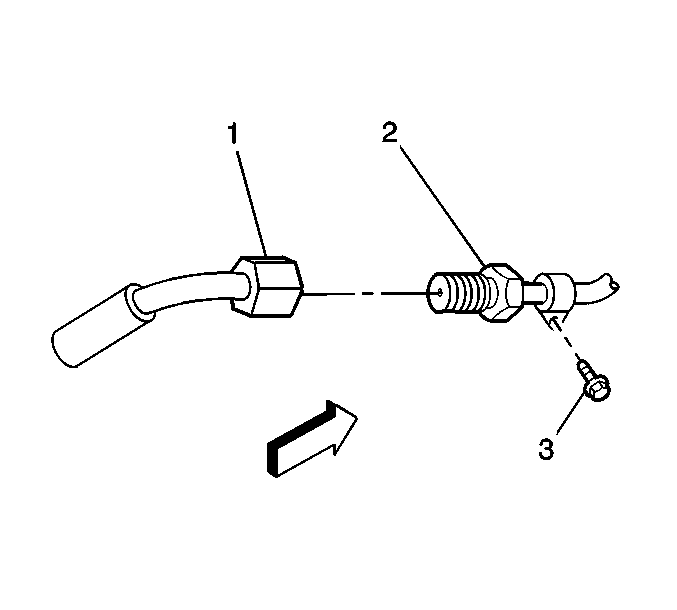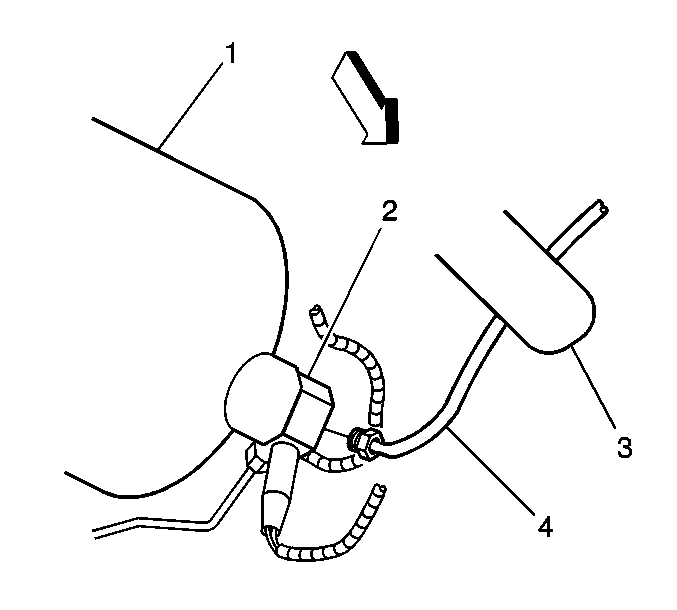Tools Required
J 41416 Ultrasonic Leak Detector
Removal Procedure
- Relieve the CNG fuel system pressure. Refer to the Fuel Pressure Relief .
- Disconnect the negative battery cable. Refer to Battery Negative Cable Disconnection and Connection in Engine Electrical in the G Van Service Manual.
- Remove the fuel tank shield. Refer to Fuel Tank Shield Replacement .
- Disconnect the fuel line fitting (1) at the line union (2).
- Disconnect the fuel line (4) from the front tank high pressure lock-off (2) fitting.
- Remove the fuel line assembly from the vehicle.
Caution: Natural gas is highly flammable. In order to reduce the risk of fire and personal injury, keep sparks, flames, and smoking materials away from the vehicle while you perform the Compressed Natural Gas (CNG) fuel system service.
Caution: The Compressed Natural Gas (CNG) system operates at pressures up to 24820 kpa (3600 psi). Relieve the CNG fuel system pressure before servicing CNG fuel system components in order to reduce the risk of fire and personal injury.
Relieve the CNG fuel system pressure. Refer to the Fuel Pressure Relief .
Caution: Unless directed otherwise, the ignition and start switch must be in the OFF or LOCK position, and all electrical loads must be OFF before servicing any electrical component. Disconnect the negative battery cable to prevent an electrical spark should a tool or equipment come in contact with an exposed electrical terminal. Failure to follow these precautions may result in personal injury and/or damage to the vehicle or its components.


Installation Procedure
- Install the fuel line assembly between the front tank and the fuel line union.
- Connect the fuel line (4) to the front tank high pressure lock-off (2) fitting using new O-rings. Lubricate the O-ring with petroleum jelly before installation.
- Connect the fuel line (1) to the line union fitting (2) using new O-rings. Lubricate the O-ring with petroleum jelly before installation.
- Connect the negative battery cable. Refer to Battery Negative Cable Disconnection and Connection in Engine Electrical in the G Van Service Manual.
- Prime the CNG fuel system by cycling the ignition ON and OFF several times.
- Start the engine and use the J 41416 in order to inspect for CNG fuel system leaks at each serviced fitting.
- Install the fuel tank shield. Refer to Fuel Tank Shield Replacement .

Caution: Natural gas is stored under high pressure. If a leak occurs, the high pressure could cause a personal injury. In order to prevent Compressed Natural Gas (CNG) fuel leaks, always replace the CNG fuel system O-rings during service.
Notice: Use the correct fastener in the correct location. Replacement fasteners must be the correct part number for that application. Fasteners requiring replacement or fasteners requiring the use of thread locking compound or sealant are identified in the service procedure. Do not use paints, lubricants, or corrosion inhibitors on fasteners or fastener joint surfaces unless specified. These coatings affect fastener torque and joint clamping force and may damage the fastener. Use the correct tightening sequence and specifications when installing fasteners in order to avoid damage to parts and systems.
Tighten
Tighten the fuel line fitting to 37 N·m (27 lb ft).

Tighten
Tighten the fuel line fitting to 37 N·m (27 lb ft).
